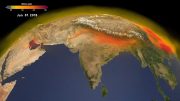
Wetland methane emissions are the largest natural source in the global methane budget, contributing to roughly one third of total natural and anthropogenic emissions. Credit: SUN Gehui
An international team of researchers has revealed that tropical terrestrial methane (CH4) emissions explain more than 80% of the observed changes in the global atmospheric methane growth rate over 2010-2019.
The study will be published in the journal Nature Communications today (March 16, 2022).
CH4 is the primary non-carbon dioxide (CO2) greenhouse gas. “On the 20-year scale, the warming effect of CH4 is 84 times that of CO2,” said Prof. LIU Yi from the Institute of Atmospheric Physics (IAP) of the Chinese Academy of Sciences.
Methane has a short life (about one-tenth of carbon dioxide), and its emission reduction can achieve the purpose of restraining the rapid global warming in a short time.
The researchers have found that methane concentration in the atmosphere has more than doubled since the pre-industrial era, contributing 20% of present-day human-induced global warming. Tropical terrestrial CH4 emissions, as the main contributor, represent ~60% of the global totals and describe 84% of the global annual mean growth rate in the 2010s.
Meanwhile, for the first time, the researchers found strong seasonal correlations in sea surface temperature over the tropical oceans and regional variations in methane emissions (via changes in rainfall and temperature) over tropical South America and tropical Africa.
“Sea surface temperature variations could be used to help forecast variations in global atmospheric CH4,” said paper author LIANG Feng from the University of Edinburgh in the UK.
In the future, the team will further use multi-platform observations to report methane emissions in China to provide scientific and technological support for China’s goal of carbon neutrality.
Reference: “Tropical methane emissions explain large fraction of recent changes in global atmospheric methane growth rate” by Liang Feng, Paul I. Palmer, Sihong Zhu, Robert J. Parker and Yi Liu, 16 March 2022, Nature Communications.
DOI: 10.1038/s41467-022-28989-z
This work was supported in part by the Chinese Academy of Sciences, the UK Natural Environmental Research Council National Centre for Earth Observation, the European Space Agency, the Royal Society of London, the National Key Research and Development Program of China.









“Tropical terrestrial CH4 emissions, as the main contributor, represent ~60% of the global totals and describe 84% of the global annual mean growth rate in the 2010s.”
They don’t even mention the concerns about increased methane from the tundra. Methane may be 84X as effective as CO2 as a GHG, but the quantities are much less than CO2, being commonly measured in parts per billion, rather than parts per million as for CO2. The attendees at COP-26 were excited about reducing methane. However, the anthropogenic part of the annual flux growth (<<1.9 PPB = 16% x 12 PPB) is trivial compared to the natural sources. That compares to an annual increase of CO2 of about 2,500 PPB.
I do wish these researchers would play on a level playing field and put everything in context.